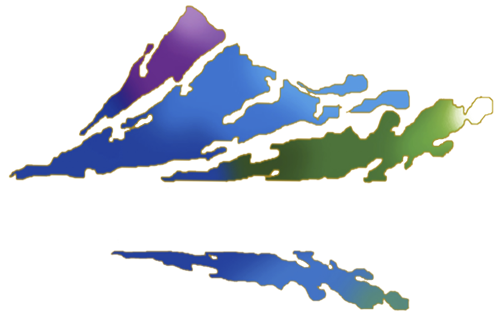Print Works
Last Light

Edition Size 75 - $130.00
Print Size - 11 ¾" x 17"
Cowboys and chuckwagons were a requirement for gathering and moving cattle and horses and later romanticized in our history through paintings, books and movies.
The Cowboy’s workday was approximately 15 hours most of which was in the saddle. When evening arrived those cowboys not working spent a little of their “off time” entertaining themselves around the chuckwagon. Favorite pastimes included story telling, games including mumbley-peg, cards and dice.
“Last Light” reminds me of adventurous young men on the western prairies making a living in the saddle enduring difficult work in a dangerous environment. Often when in the saddle riding a trail I think of the adventures and hardships experienced by cowboys and others who settled the West.
X
Lemitar Cholla Cactus
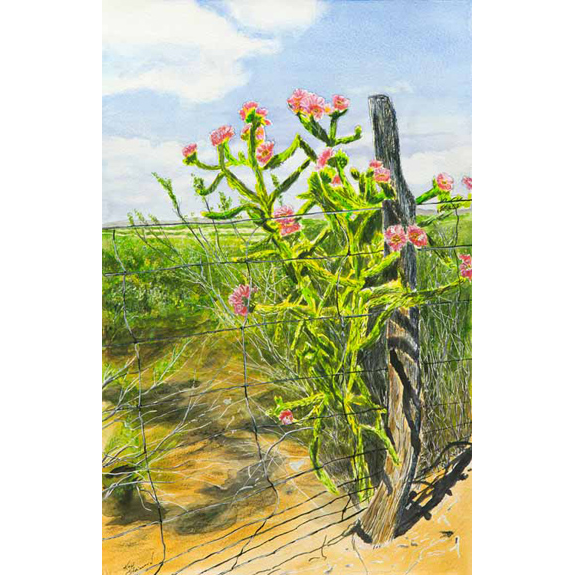
Edition Size 50 - $115.00
Print Size - 16½" x 10¾"
While driving through Lemitar, New Mexico I marveled at all the Cholla cactus in bloom. This particular cactus was my favorite as it was supported by a natural fence post with multi-strand wire. I did discover the cactus barbs are to be avoided at all costs.
X
Lone Star Bridle
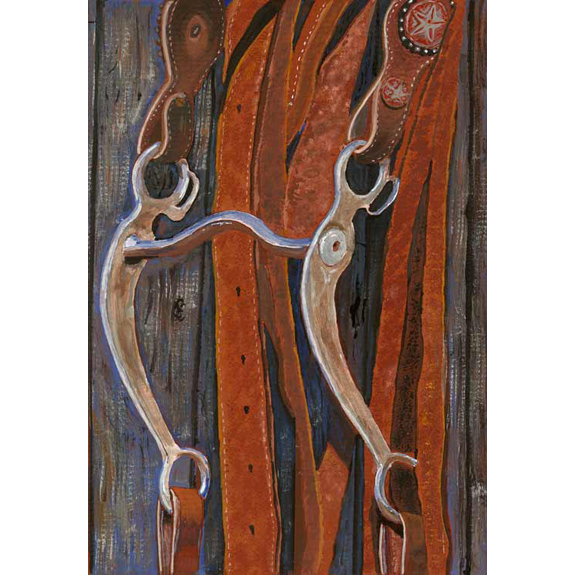
Edition Size 75 - $60.00
Print Size - 10½" x 7¾"
Some of the best experiences of my life have been on horseback filling my senses with the smell and sounds of saddle leather as a good horse moves along a quiet scenic trail. “Lone Star Bridle” is a visual reminder tack is better put to use on a horse then hanging in a tack room. Horseman will notice this bridle could lead to a wild ride lacking a curb strap!
X
Lucia
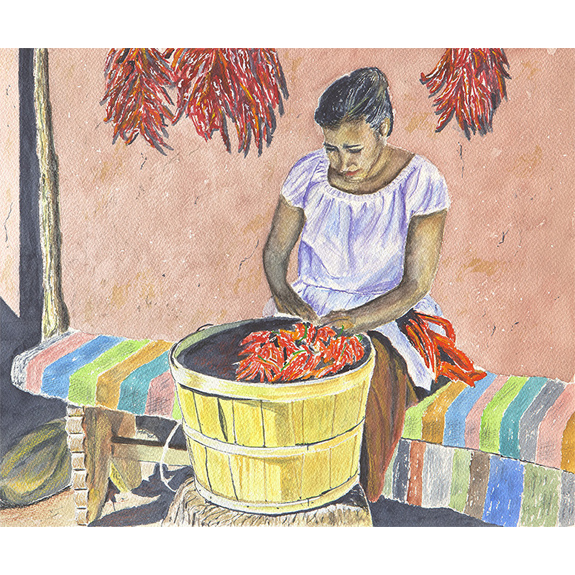
Edition Size 75 - $90.00
Print Size - 10¾" x 13"
Lucia is a popular Spanish and Italian name meaning “Graceful Light”. The name seemed appropriate for the lighting, color and subject of this painting. I discovered Lucia stringing chile ristras at El Rancho de las Golondrinas in Santa Fe. I was drawn to the color and harvest activity depicted in the painting.
X
Manzano Adobe

Edition Size 75 - $115.00
Print Size - 10½" x 16½
Nature has a way over time to remove physical history from the landscape. This is evident in the small town of Manzano, New Mexico and an adobe farmhouse on the edge of town. The Manzano mountains and plains to the east had been visited by Native Americans for thousands of years prior to Europeans arriving and establishing the town of Manzano in 1815. Manzano is Spanish for "apple tree" and is a likely reference to two apple orchards that were present at the time of the town's founding. Adobe is a natural building material made from sand, clay, water, and some kind of fibrous organic material which the builder shape into bricks and dry in the sun. Adobe structures account for some of the oldest existing buildings in the world. Adobe structures have been found to date to the eighth century BC. New Mexico settlers relied on adobe to build their homes and adobe homes are still in use today throughout the state.
X
Moon Over Soccoro
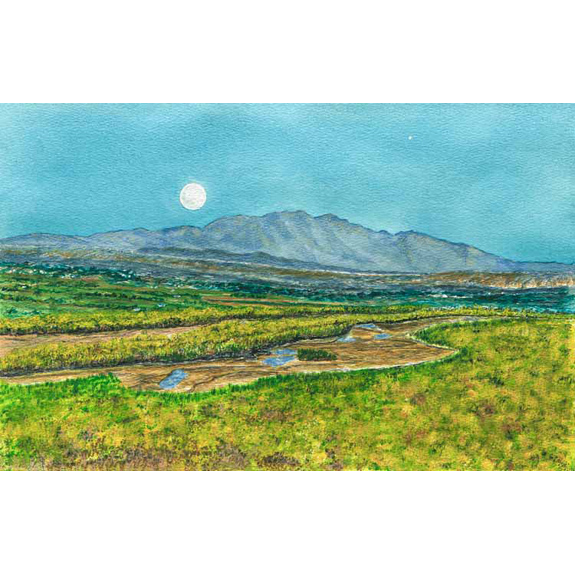
Edition Size 50 - $115.00
Print Size - 10½" x 16½
Socorro is Spanish meaning to “give aid, to give succor” relates to the Piro Indian gift to the first expedition of Spanish families traveling north from Mexico in 1598, led by Don Juan de Oñate y Salazar. The Spanish expedition arrived in the Rio Grande River valley in need of food for man and beast. The people of the Teypana Pueblo welcomed the scouting party of Oñate and his men and provided the aid they desperately needed. When the Teypana Pueblo people unexpectedly gave the expedition a large gift of food, Oñate renamed the pueblo Socorro.
“Moon over Socorro” is a reminder of the fall colors and harvest shared between two peoples centuries ago and today.
X
Mountain Graze Lands
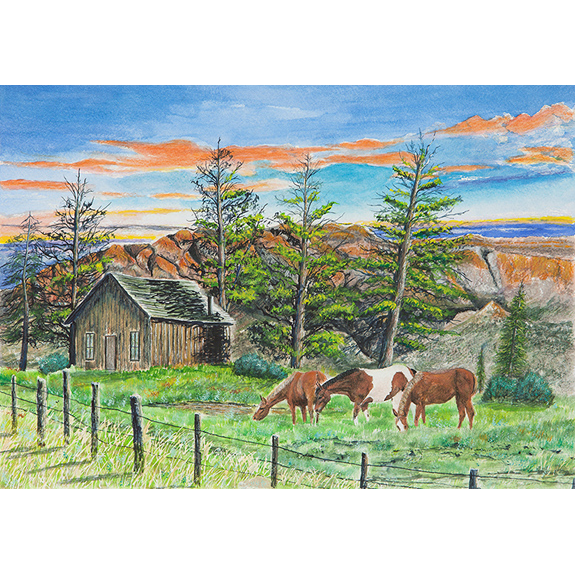
Edition Size 75 - $130.00
Print Size - 11¾" x 17"
Every feature in this painting I greatly enjoy from the beautiful New Mexico sunsets, mountains and pines, ranch cabins to the ingenuity of barbwire along with tree limb and trunk fence posts. To arrange and paint all these wonderful visual and real experiences into a single painting is a documentation of many outdoor experiences I enjoy the most.
X
Mustangs

Edition Size 75 - $100.00
Print Size - 9½" x 15½"
Many American cowboy practices can be traced back to Mexico and Spain and one such practice is the roundup and branding of stray cattle. For centuries unowned ranging cattle were rounded up and sold. The Spanish word for this roundup was “mesta”. From mesta the Spanish word “mestengo” originated meaning “a wild or stray animal.” With the reintroduction of the horse in the United States from Spain the English borrowed the word mestengo and created the word “mustang.” What a thrill for me to see mustangs here in the southwest United States.
X
Ned
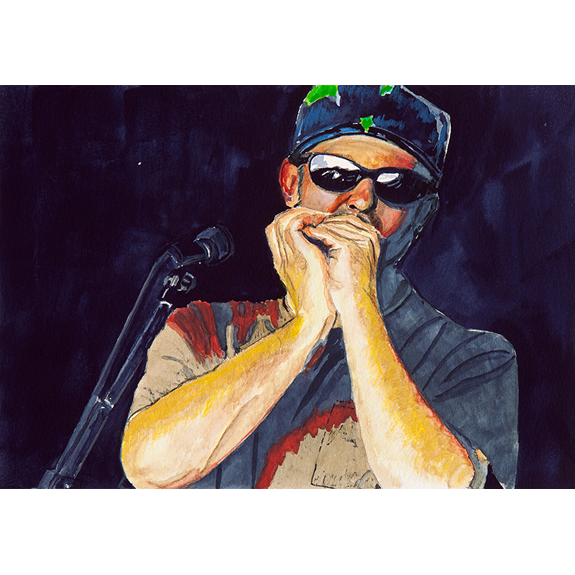
Edition Size 75 - $60.00
Print Size - 7¾" x 11"
“Ned” is a close friend and accomplished French harp player living in Fairbanks, Alaska. I wanted to paint this image of Ned playing the harp in a slightly impressionistic manner and I am delighted with the end product.
X
Night Camp
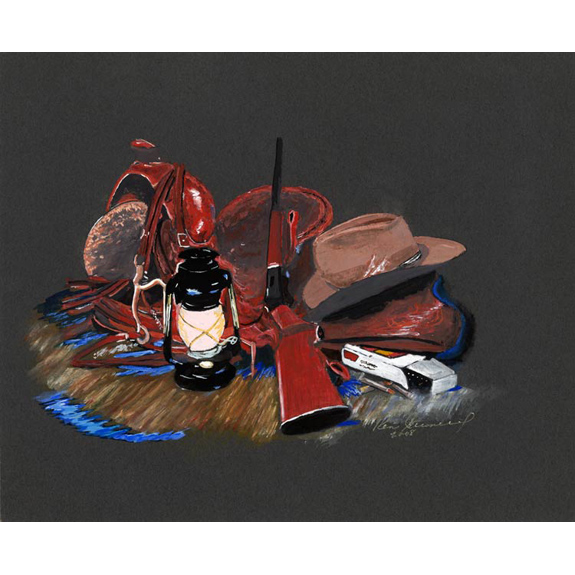
Edition Size 75 - $110.00
Print Size - 11" x 14"
“Night Camp” is my visual reminder of horseback moose hunting trips into the Alaska Range. On these fall hunting adventures we often rode close to moose and saw all species of wildlife whose home or migration took them through these majestic mountains. This painting brings back for me the smell of saddle leather, the visual reminder of God’s greatest creation, and good company sharing a hot pot of coffee at an evening campfire. Good times….at “Night Camp.”
X
Peaceful Night
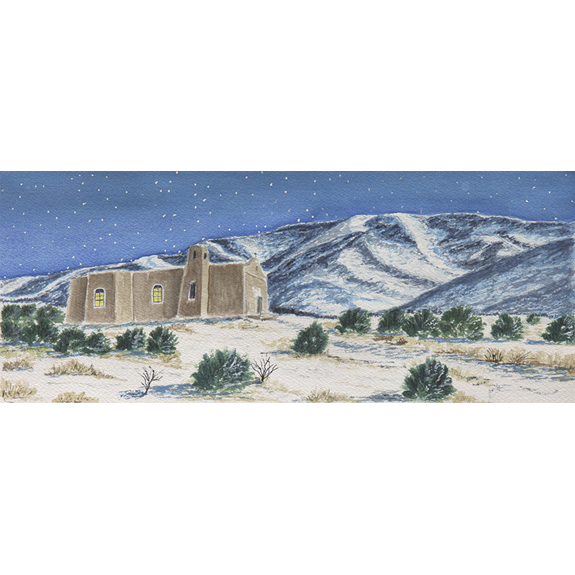
Edition Size - 75 - $60.00
Print Size 6" x 14½"
Throughout New Mexico adobe brick churches remind us of the important role religion and faith have in the development and history of the state. In many New Mexico communities it is the small adobe church that stands and continues to anchor the faithful in the area. This is the case in Golden, New Mexico mostly a ghost town from the gold mining days of the 1800’s. San Francisco de Asis an adobe church constructed in 1839, at the base of the San Pedro Mountains, continues to provide religious services to the mountain community.
Saint Francis of Assisi, a 12th century Italian Catholic friar and founder of the Franciscan Order is one of the most venerated religious figures in history and known as the patron saint of animals and the environment. He is also credited for arranging the first nativity scene.
X
Prickly Pear Clovis Point
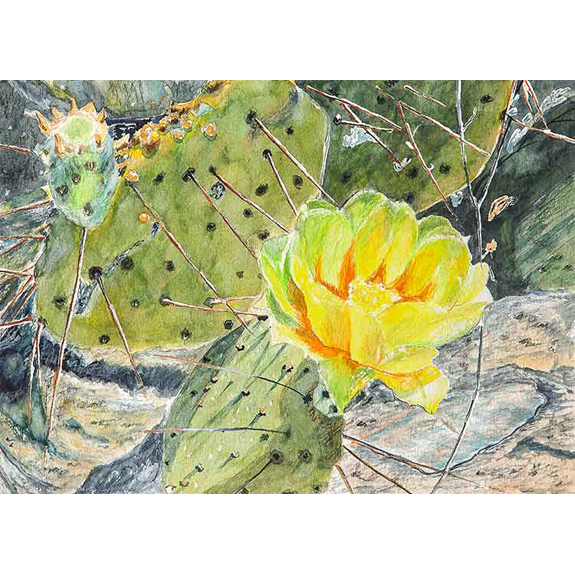
Edition Size - 75 - $55.00
Print Size 7½" x 10½"
Prickly pear cactus represents about a dozen species of the Opuntia genus and can be found in all the deserts of the American Southwest. The beautiful flowers can be yellow, red, or purple. The large fleshy pads have several functions including water storage, photosynthesis, and flower production. The fruits of the prickly pear are edible and sold in stores under the name “tuna.” There have been some medical studies that show this cactus has a positive effect on cholesterol, insulin, and blood sugars
I painted in a “Clovis point” in the lower right hand corner of the painting. Clovis points are fluted projectile points associated with the Clovis culture and are named after the city of Clovis, New Mexico where examples were first found in 1929. They date to Paleo-Indian period around 13,500 years ago. My brother found this point while we were searching for 16th century Spanish gold mines. Archeologists from Cibola National Forest Service recovered the point.
X
Range Boss
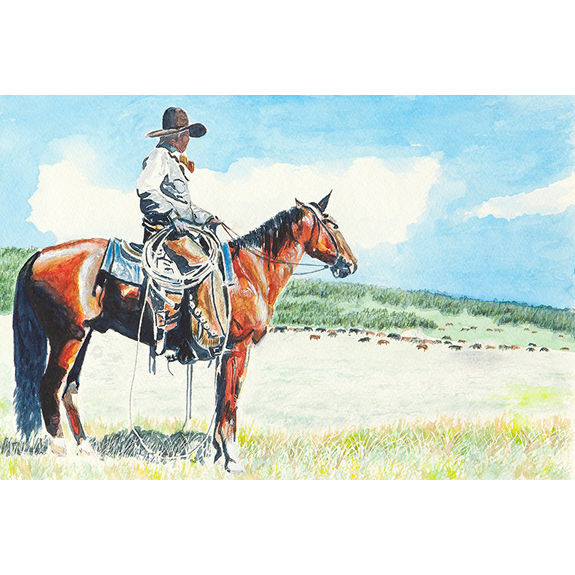
Edition Size 75 - $75.00
Print Size - 8½" x 12½"
In a cattle outfit the manager of all operations while on the range was referred to as the Range Boss. The success of the cattle operation hinged on the overall management, knowledge and capabilities of this range manager. His knowledge and management of livestock, weather, supplies, available feed and personnel were critical to the overall success of the raising cattle in the West.
X
Buckaroo
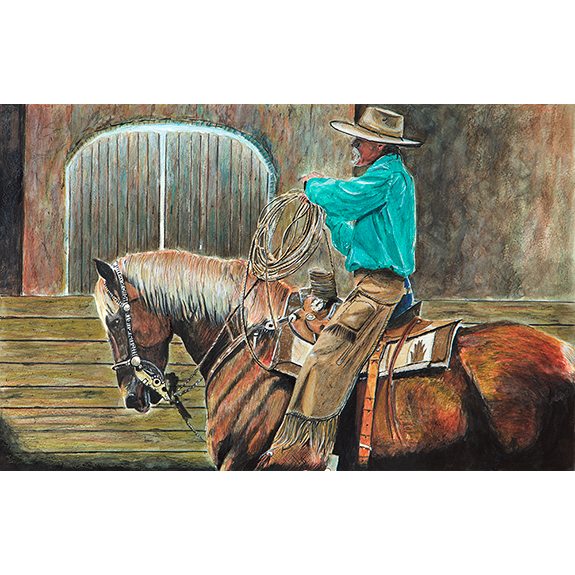
Edition Size 75 - $110.00
Print Size -10" x 16 ¾"
It is said that great differences exist between the two cultures and styles of stockmanship the American cowboy and his Spanish counter the vaquero aka buckaroo. Supporters of Vaquero/Buckaroo horsemanship claim it is more light-handed, more humane method of work than that of the traditional cowboy. The dress and equipment each use can often differentiate. Buckaroos tend to prefer a shorter form of legging, called chinks. There is also a more natural and less flashy type of legging used, called Armitas. Cowboys tend to prefer the batwing chaps or shotgun chaps. Cowboys can be distinguished by the synonymous hat that we see throughout the modern western culture and throughout Hollywood! Buckaroos tend to prefer a more flat-crowned and flat-brimmed hat. Buckaroos often like the use of a rawhide reata, instead of the nylon and/or poly rope. The longer, the better for buckaroos. Buckaroos also prefer a more flashy and larger style of spurs than do their cowboy counterparts, as with their bits too. Buckaroos prefer a more ornately decorated spade bit, which takes a long process and years of horse training to get to, whereas cowboys will utilize a more simplistic curb bit or something similar. Saddles have many differences between the two cultures as well. Cowboys utilize a more generic, western-style saddle from which they can rope from. Buckaroos employ what is referred to as a Slick Fork Saddle, one with a larger Mexican or California style horn, which lends itself to better dallying and more ease of use. These are some of the difference between cowboys from two cultures. The similarities include love of horsemanship and ranch work.
X
Fly Rods & Reels
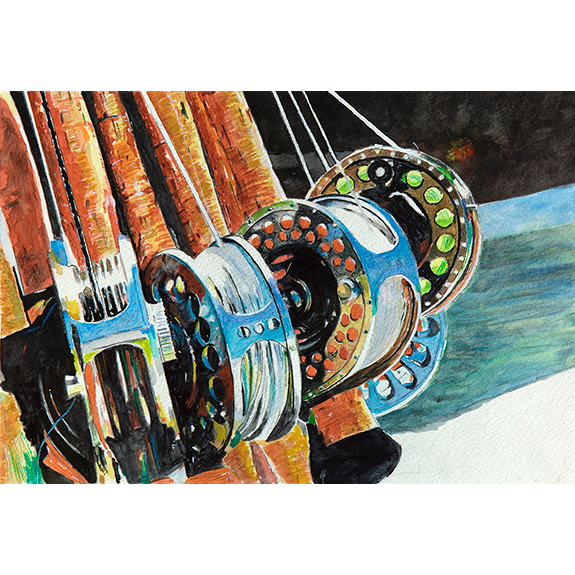
Edition Size 75 - $110.00
Print Size - 8 ¾" x 12 ¾"
One of my passions is fly fishing. The thrill of fishing a clear stream with a dry fly and experiencing a rising fish strike repeatedly takes me back to mountain streams and rivers for the outdoor experience. I believe I got this interest in fishing from my Dad who enjoyed this sport and many others. I think of my Dad often when fishing and remember the times he took us kids fishing on hot summer days in the midwest.
